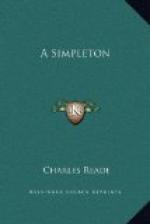PREFACE.
It has lately been objected to me, in studiously courteous terms of course, that I borrow from other books, and am a plagiarist. To this I reply that I borrow facts from every accessible source, and am not a plagiarist. The plagiarist is one who borrows from a homogeneous work: for such a man borrows not ideas only, but their treatment. He who borrows only from heterogeneous works is not a plagiarist. All fiction, worth a button, is founded on facts; and it does not matter one straw whether the facts are taken from personal experience, hearsay, or printed books; only those books must not be works of fiction.
Ask your common sense why a man writes better fiction at forty than he can at twenty. It is simply because he has gathered more facts from each of these three sources,—experience, hearsay, print.
To those who have science enough to appreciate the above distinction, I am very willing to admit that in all my tales I use a vast deal of heterogeneous material, which in a life of study I have gathered from men, journals, blue-books, histories, biographies, law reports, etc. And if I could, I would gladly specify all the various printed sources to which I am indebted. But my memory is not equal to such a feat. I can only say that I rarely write a novel without milking about two hundred heterogeneous cows into my pail, and that “A Simpleton” is no exception to my general method; that method is the true method, and the best, and if on that method I do not write prime novels, it is the fault of the man, and not of the method.
I give the following particulars as an illustration of my method:
In “A Simpleton,” the whole business of the girl spitting blood, the surgeon ascribing it to the liver, the consultation, the final solution of the mystery, is a matter of personal experience accurately recorded. But the rest of the medical truths, both fact and argument, are all from medical books far too numerous to specify. This includes the strange fluctuations of memory in a man recovering his reason by degrees. The behavior of the doctor’s first two patients I had from a surgeon’s daughter in Pimlico. The servant-girl and her box; the purple-faced, pig-faced Beak and his justice, are personal experience. The business of house-renting, and the auction-room, is also personal experience.
In the nautical business I had the assistance of two practical seamen: my brother, William Barrington Reade, and Commander Charles Edward Reade, R.N.
In the South African business I gleaned from Mr. Day’s recent handbooks; the old handbooks; Galton’s “Vacation Tourist;” “Philip Mavor; or, Life among the Caffres;” “Fossor;” “Notes on the Cape of Good Hope,” 1821; “Scenes and Occurrences in Albany and Caffre-land,” 1827; Bowler’s “South African Sketches;” “A Campaign in South Africa,” Lucas; “Five Years in Caffre-land,” Mrs. Ward; etc., etc., etc. But my principal obligation on this head is to Mr. Boyle, the author of some admirable letters to the Daily telegraph, which he afterwards reprinted in a delightful volume. Mr. Boyle has a painter’s eye, and a writer’s pen, and if the African scenes in “A Simpleton” please my readers, I hope they will go to the fountain-head, where they will find many more.




